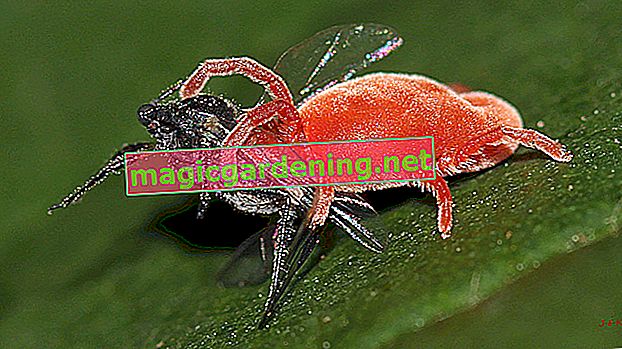
the essentials in brief
- Red velvet mite is one of the beneficial insects in the garden, as it kills pests and their eggs.
- It is especially common in warm and dry places, such as B. on the terrace or in the living room.
- However, it can be kept away with simple means (insect screens, pollen net).
- The species is easily affected by outwardly very similar pests, e.g. B. the fruit tree spider mite to be confused.
What is the red velvet mite?
The red velvet mite (lat. Trombidium holosericeum), which is between one and four millimeters in size, is a local representative of the so-called running mites. The animals are popularly known as velvet mites or mites and are widespread.
also read
- Peel beetroot or cream properly
- Fire beetle - dangerous pest or useful?
- Freeze beetroot - only freeze the red tuber when it is cooked
In the summer months - especially in autumn, when it gets cooler - they like to make themselves comfortable in houses and apartments, after all they are looking for a suitable option for wintering. The red velvet mite is one of the predatory mite species and feeds primarily on other insects and their eggs.
Little red spiders in the garden or on the terrace? Recognize and differentiate between species
Not every red arachnid that crawls in your garden or on the living room carpet is a red velvet spider. There are many different small, red arachnids, and some of them are actually not wanted in the garden. So before you pull out the vermin spray or want to combat the red velvet mite in any other way, first take a look at what species it actually is
The useful red velvet mite is often confused with the fruit tree spider mite or red spider. For this reason, the following table gives you an overview of the respective species-typical characteristics for better differentiation.
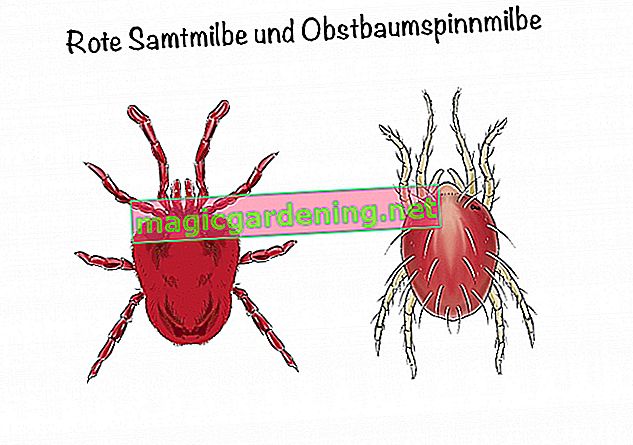
| Red velvet mite | Fruit tree spider mite | |
|---|---|---|
| Latin name | Trombidium holosericeum | Panonychus ulmi |
| Popular names | Velvet mite, mites, blood animals | Red spider |
| size | 1 to 4 millimeters | 0.5 to 06 millimeters |
| Hairiness | densely haired body, appears velvety | none, but females have clearly protruding bristles on their backs |
| colour | scarlet | carmine |
| Typical body features | long forelegs, scissor-like jaws, enlarged abdomen | little pronounced, clumsy |
| head | relatively large, small eyes | significantly smaller head |
| Occurrence | often on walls, terraces, dry lawns | mainly on woody plants, e.g. B. Fruit trees and vines |
Is the red velvet mite dangerous?
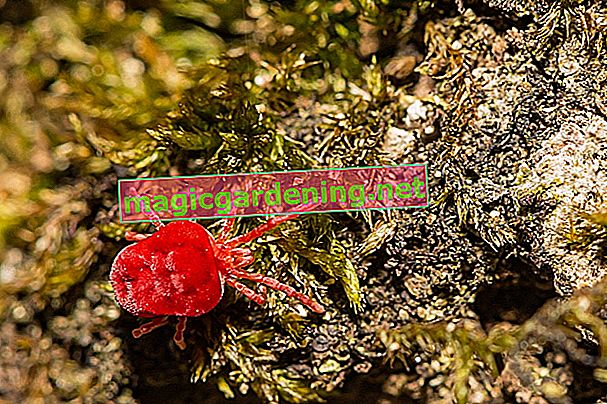
No, the red velvet mite is not dangerous - at least not for people, pets or garden plants. The little animals are actually only interested in other, ground-living and soft-skinned insects that they hunt and suck up. Most of all, however, they prefer to eat insects, especially pests that are common in the garden, and thus contain their population.
If you often find this type on your terrace or even in your apartment, then there is a very simple reason: it is already warm and dry there. The mites prefer such a climate, not only (but especially) in autumn when they are looking for a suitable place to hibernate.
How do I recognize the red velvet mite bite?
Since the red velvet mite does not have a sting, it cannot sting. Their mouthparts are also not pronounced enough to penetrate human skin, for example. So this species cannot bite either! A possible mite bite can be traced back to completely different species, such as these:
- Autumn or harvest mites : yellow to pale red, tiny mites that prefer to be in damp places in the garden (also in the compost) and are often responsible for very itchy bites
- Grave mite or itch mite : Sarcoptes scabiei, caused by burial burrows in the skin. Scabies
- Bird mites : Infestation occurs more frequently in bird owners (chickens, pigeons, etc.), but can also be transmitted by infested garden birds (e.g. through contact with contaminated nests)
- Grass mites : Grass mites are very common in the garden and like to bite
Characteristic of mite bites are:
- red spots on the skin
- often do not occur individually, but multiple times (multiple bites)
- itch badly
- The cause has often already disappeared, so itchy areas are usually inexplicable
Digression
Does the red velvet mite actually transmit borreliosis?
It is often claimed that the red velvet mite transmits Lyme disease. The probability that this will happen, however, is negligible - after all, the little animals are not bloodsuckers that would bite or sting people. However, the disease can be transmitted by other types of mites (see above) or above all ticks.Do I have to fight the red velvet mite?
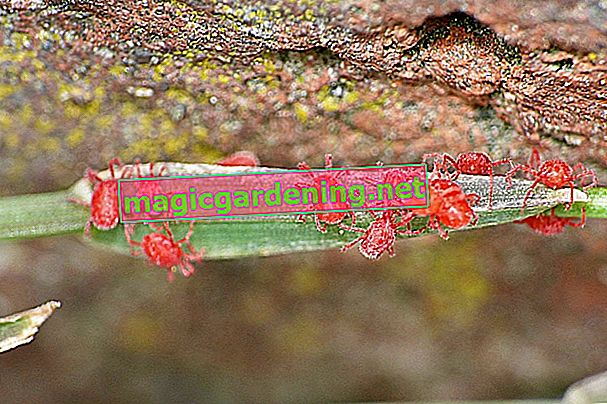
The red velvet spider is a definite beneficial insect, because the industrious little animal eats all kinds of insects that are harmful to garden plants, such as aphids or snail eggs, with great appetite. For this purpose, the adult animals not only run around on the ground, but also on walls and plants. So if you spot red arachnids on your vine or the apple tree, it is not automatically a fruit tree spider mite - instead it can also be a red velvet spider on the hunt for the fruit tree spider mite.
Incidentally, it is sometimes claimed that the animal itself would occasionally draw off sap. This is wrong as it is a pure hunter. The mistake probably arises from the confusion with the fruit tree spider mite, also known as the “red spider” and externally quite similar.
As a result, fighting the red velvet spider does not make much sense, after all you would deprive yourself of an important fighter against the pest in the garden.
The following video shows fascinating images of hunting red velvet spiders:
YoutubeRed velvet mite is important for healthy soil
Not only does the red velvet mite eat harmful insects and their eggs, it is also important for the garden for another reason: it is part of the arthropods, which maintain the structure of the soil and is also relevant for humus formation. The species spends two developmental stages in the soil surface, where it feeds on bacteria and fungi in addition to soil-dwelling insects and insect eggs. Therefore it contributes to the splitting of the soil components and thus to the formation of the humus which is so important for plant growth.
Red velvet mite in the house? This is how you get rid of the animals
Sometimes, however, the animals appear too numerous on the terrace or even in the apartment that you would like to get rid of them despite all the advantages. This works best with the following methods.
Digression
Red arachnids in the chicken coop
If you see small red arachnids crawling around in the chicken coop or even on top of the chickens, it could possibly be the red mite. You should fight these immediately, as this small bloodsucker causes considerable damage to the chickens. Red mites reach a maximum size of about one millimeter and are not velvety hairy.Spray the terrace with water
Red velvet mites especially like to stay in dry places. You can drive the animals away from your patio or living room by keeping the surfaces moist. You should therefore regularly spray stone surfaces with the garden hose, whereby your main focus should be on structures made of natural stone. Water the garden - and especially the lawn! - more often during more intense dry periods and do not forget to wipe the garden furniture.
Build a barrier out of thick glass
A defense barrier made of thick glass (e.g. thick-walled glass blocks) has also proven itself, because the red velvet mite (and also some other annoying types of insects and mites) find it quite uncomfortable to walk over such a surface. In this way you reliably keep the animals on the terrace and in the house at bay and also create an attractive decorative element.
Keep doors and windows closed
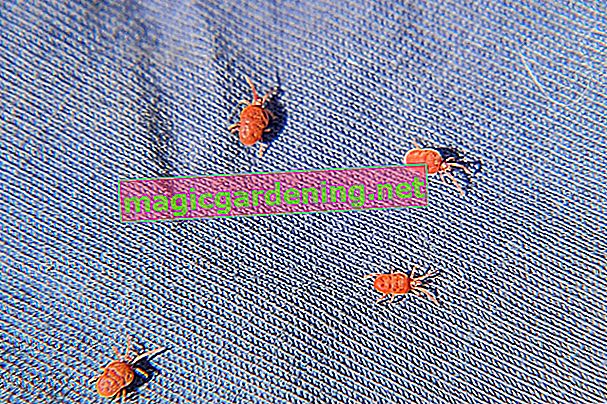
To prevent the little crawlers from getting lost in your apartment, you should keep doors and windows closed, especially overnight. During the evening hours, red velvet mites look for a warm place to stay and therefore like to wander into houses. However, if all openings are closed, the animals must stay outside. Caution: Red velvet mites can also get through cat flaps and doors or windows that are not tightly closed. Because of their small size, they can take advantage of virtually any gap. Another disadvantage of this method is that very few people like to lock all doors and windows in summer.
Digression
Do not crush red velvet mite
If you see a red velvet mite crawling around safely: don't crush it! The animals leave red spots that are very difficult to remove from (light) clothing or terrace floors. It is not for nothing that they are popularly referred to as “blood animals”.Install insect screens
Especially if you live on the ground floor or on the mezzanine floor of a house or have a terrace that leads into the garden, you can sometimes be teeming with small red arachnids. It is warm and dry in your apartment, which the red velvet mite appreciates and therefore likes to claim for itself. It is therefore best to keep the arachnids away from the start with a close-meshed insect screen or screen. Such devices are easy to install and also offer the advantage that they also reliably keep other annoying insect species away. In addition, you can now leave doors and windows open to your heart's content.
Vermin spray - yes or no?
"Do you really have to kill everything just because you are disgusted with it?"
If nothing else works, you can use vermin spray to spray an odor barrier around the patio or in front of the patio door. These agents are more effective than traditional vermin spray, which tries to kill the mites (and is not really successful with it). However, do not use these agents indoors (toxins!) And think carefully about how to use them. Biocides are not only effective against the red velvet mite, they also have other serious disadvantages:
- The effect lasts between six weeks and six months, depending on the product.
- Biocides also act against other insects, some of which are important for the garden (bees, bumblebees).
- They are also extremely toxic to aquatic organisms.
- As a result, they may seriously pollute water sources in the garden.
- Biocides irritate the skin and the mucous membranes.
- Misuse can cause eczema, rashes, or cracks in the skin.
Nevertheless, such a chemical odor barrier can be useful if, for example, the population of the red velvet spider gets out of hand and you don't know what else to do in view of the sheer mass.
frequently asked Questions
How common is the red velvet mite?
The red velvet mite is widespread in Central and Southern Europe. It does not prefer special habitats, but occurs just as frequently in mixed forests, between rocks, in the dry desert and in gardens as in apartments and houses. From late spring and all summer long, the small animals can be seen scurrying across the ground, sometimes appearing in larger numbers.
What does the red velvet mite eat?
The red velvet mite is one of the predatory mites and lives parasitically on other insects even as a nymph. Here it sucks in the tissue fluid from its host for several days - harvesters (Opilio parietinus), for example, are often affected - but only very rarely blood. As an adult, it hunts ground-dwelling insects and their larvae, such as fringed-winged birds, small caterpillars, grasshoppers, mosquitoes, aphids and plant lice, other mites and their eggs. The red velvet mite can eat up to 40 aphids per day.
How can I differentiate between harmful and beneficial species of mites?
Red spider or red velvet spider? Pest or beneficial insect? This distinction can be very important in the garden and should therefore not be made too hastily. However, the speed of movement gives you an indication of the possible species: Predatory mites (such as the useful red velvet spider) are generally fast on the move and are constantly scurrying around in the garden. In contrast, pests (such as the red spider and fruit tree spider) tend to be slow. No wonder, after all, an apple tree cannot run away.
Help, I found a red spider in my hair! What should I do now?
Nothing at all, except perhaps to carefully pull the little spider out of your hair. Red velvet spiders are not interested in people and do not bite or sting them, even other red spider species are harmless and only landed on your head by chance. So keep calm and don't worry.
What does the red velvet mite do in winter?
Red velvet mites like to spend the winter where it is warm and dry. Normally the little animals bury themselves in the upper soil layers, where they survive the cold season and then appear as adults in the following spring. The small mites can live up to a year.
Tips
A pollen net, usually intended for people allergic to all kinds of pollen, also keeps the red velvet mite out of the house and apartment.








